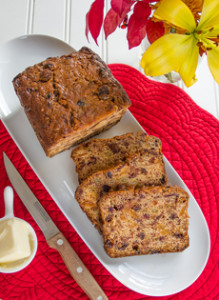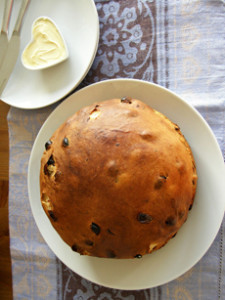HALLOWEEN: Barmbrack, An Irish Tradition
|
Fruitcake lovers and tea cake lovers: It’s time for barmbrack, also known as barm brack, barnbrack or simply brack.
Brack? The original barmbrack was a sweet yeast bread with raisins and sultanas. Barm is the term for the yeast filtered out of beer in the final stage of production, a cheaper yeast source than commercial yeast. In Ireland it is sometimes called bairín breac, Gaelic for “speckled loaf.” The speckling refers to the raisins and sultanas in the loaf. It is usually made in flattened rounds. The dough is sweet but not as rich as cake, so it can be enjoyed any time of the day. It is similar to Irish soda bread, minus the baking soda. In Ireland, barmbrack is often served with afternoon tea, toasted with butter. But barmbrack evolved into an Irish Halloween tradition. For Halloween, the traditional loaf was baked with talisman-like items inside. They formed a kind of fortune-telling game. Whoever received a slice with a talisman could interpret it thusly: |
|
|
|
Hmm: Do we want a bread or cake to predict our fortune? We think not. And as British baker Vicky of Stasty.com notes, “It kind of seems like a choking hazard now when I think about it!” (Commercially produced barmbracks for Halloween still include a toy ring.) Vicky has created her own take on bambrack, a denser speckled loaf, a fruit cake with the dried fruits steeped in tea and whiskey. |
||
|
The original barmbrack loaf resembled Irish soda bread. This one is from Maplespice.com. |
“Even though I wasn’t a fan of this fruit cake as a kid, I loved when we had barmbrack at Halloween. The reason I liked the cake so much was because it contained hidden fortune-telling treasures. For kids this was all kinds of fun, but we never cared much for the actual cake. As an adult though, I’ve grown to love fruit cakes—but I don’t bother adding trinkets.”
For this recipe, says Vicky, ”I went for a more adventurous selection of fruits than the traditional ones used in a barmbrack. “This cake contains a colorful mix of dried cherries, apricots, cranberries, blueberries, golden raisins and dates [you can also add dried figs]. It’s a really simple cake to make, and as it’s very moist, it keeps fresh for well over a week. “This barmbrack is best served with lots of salty butter and a nice, strong cup of tea on the side.” It’s her Halloween tradition. Make it one of yours. Here’s the recipe, trinkets optional. Well, maybe just the ring. As for the tea: How about a spiced tea like Constant Comment or chai? |
|
|
HALLOWEEN HISTORY Halloween has its origins in the festival of Samhain (sah-WEEN), celebrated at the end of the harvest by the ancient Celts of what is today Great Britain. (Pronunciation: It’s KELTS, not SELTS.) Samhain marked the end of the “lighter half” of the year and beginning of the “darker half.” The Halloween colors of orange and black represent the lighter side (fall harvest) and the darker side. The Celts believed that on October 31, the boundaries between the worlds of the living and the dead overlapped and the deceased returned to cause havoc. To fool the spirits and ghosts that roamed the countryside, people began to wear masks and costumes to avoid being recognized as human. To keep away spirits and ghosts on Samhain, they placed candles in their windows, using hollowed-out turnips and other vegetables as the holders. (Pumpkins, a New World fruit, took over when Irish immigrants discovered them in the U.S. in the 19th century.) Around 600 C.E., Christian missionaries replaced the pagan festival of Samhain with All Saints Day, also called All Hallows Even (even means evening), abbreviated as Hallow’een. The name Halloween is first found in 16th-century Scotland, evolving from All Hallows Eve. Afraid of Halloween? That’s called samhainophobia. CHECK OUT WHAT’S HAPPENING ON OUR HOME PAGE, THENIBBLE.COM. |
||




